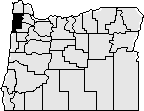
Tillamook County, the 12th county in Oregon to be organized, was established on Dec. 15, 1853, when the Territorial Legislature approved an act to create the new county out of an area previously included in Clatsop, Yamhill and Polk Counties. The county was named after the Tillamook Indians who occupied the areas around the Tillamook and Nehalem Bays.
Tillamook County is located in the northwest portion of the state and is bordered by Clatsop County on the north, Washington and Yamhill Counties on the east, Polk and Lincoln Counties on the south, and the Pacific Ocean on the west. Boundary changes were enacted with Clatsop County (1855, 1870, and 1893), Lincoln County (1893), Washington County (1893, 1898), and Yamhill County (1887). The area of Tillamook County is 1,125 square miles. The 2016 population of 25,920 represented an increase of 2.7% since 2010.
During the first 10 years following the organization of the county, the county court met at the homes of its members. From 1865 to 1875 court sessions were held in various schoolhouses in the district, the exact place being determined by the incumbent county judge. In 1866 the town of Lincoln was renamed Tillamook in order to stay consistent with the post office's name of Tillamook. An election in 1873 chose Tillamook as the county seat. In 1875 the county rented an office in the general store to house government. In 1889 a courthouse was built but was destroyed by fire in 1903. Only the county clerk's vault and its stored records were saved. A new courthouse was built at the same site in 1905 and replaced again in 1933.
County government offices that were in place upon statehood were the three county commissioners (including the county judge), a probate judge, sheriff, clerk, treasurer, assessor, school superintendent, and coroner. Subsequent officers and/or boards were established as follows: surveyor (1860); stock inspector (1895); school district boundary board (1899); veterinarian (1910); health officer (1912); fair board (1913); agricultural agent (1915); dairy herd inspector (1917); dog control districts (1919); and an engineer (1925).
The major physical features of Tillamook County consist of the rocky and irregular coastline that forms the county's western boundary, stretches of coastal lowlands, and heavily timbered interior parts, which comprise the main span and several spurs of the Coast Range. Principal industries are agriculture, lumber, fishing, and recreation. Dairy farms dominate the county's fertile valleys providing milk for the well-known Tillamook cheese. Logging and lumbering became a significant economic force due to the reforestation of most of the "Tillamook Burn" area. With seventy-five miles of coastline, four bays, and nine rivers, recreational and tourist facilities are numerous. The Tillamook airbase for blimps was commissioned on December 1, 1942, with the name U.S. Naval Air Station. It was closed after World War II. Tillamook and Yamhill counties also hosted the Mt. Hebo Air Force Station, which played an important part in air defense during the Cold War, from 1956 to 1980.